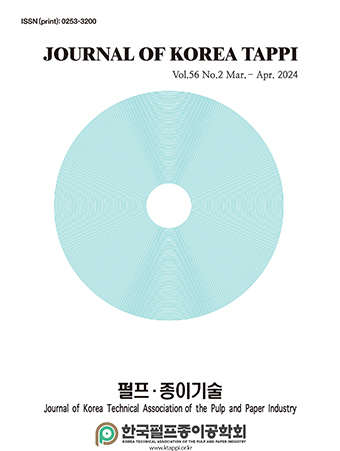Research Article
Leslie, H. A., Plastic in cosmetics: Are we polluting the environment through our personal care?, Report from United Nationals Environmental Programme (UNEP) (2015).
Ghosh, S., Sinha, J. K., Ghosh, S., Vashisth, K., Han, S., and Bhaskar, R., Microplastics as an emerging threat to the global environment and human health, Sustainability 15(14):10821 (2023).
10.3390/su151410821Moon, S. M., Jeon, S. H., Eom, T., and Shim, B. S., Recent research trends in eco-friendly materials for solving environmental micro-plastic problems, Prospectives of Industrial Chemistry 22(2):25-43 (2019).
Choi, J. Y., A study on biopolymer as a future fiber material, Journal of the Korean Society Design Culture 18(1):481-493 (2012).
Klemm, D., Heublein, B., Fink, H. P., and Bohn, A., Cellulose: Fascinating biopolymer and sustainable raw material, Angewandte Chemie International Edition 44:3358-3393 (2005).
10.1002/anie.20046058715861454Choi, K. H., Choi, J. S., Lee, C. W., Lee, K. S., and Ryu, J. Y., Study on the gas grafting efficiency of paper according to carbon number of fatty acid chloride, Journal of Korea TAPPI 52(4):5-11 (2020).
10.7584/JKTAPPI.2020.08.52.4.5Noh, K. H., Shin, Y. R., Kang, H. J., Kim, H. B., and Ryu, J. Y., Effect of hydrophobization of paper by gas grafting on physical properties of recycled paper, Journal of Korea TAPPI 55(2):3-9 (2023).
10.7584/JKTAPPI.2023.4.55.2.3Shin, Y. R., Noh, K. H., You, H. U., Kim, H. U., Lee, J. S., Ryu, J. Y., Study on dispersion characteristics of HwBKP hydrophobized by repeated gas grafting in polypropylene, Journal of Korea TAPPI 55(2):59-66 (2023).
10.7584/JKTAPPI.2023.4.55.2.59Jonoobi, M., Harun, J., Mathew, A. P., Hussein, M. Z. B., and Oksman, K., Preparation of cellulose nanofibers with hydrophobic surface characteristics, Cellulose 17:299-307 (2010).
10.1007/s10570-009-9387-9Lee, Y., Kim, D., Eom, T. J., Lee, J. M., and Kim, K. J., Facile acetylation of woody biomass using a glycol ether solvent, Journal of Korea TAPPI 53(3):15-22 (2021).
10.7584/JKTAPPI.2021.06.53.3.15Andresen, M. and Stenius, P., Water-in-oil emulsions stabilized by hydrophobized micro-fibrillated cellulose, Journal of Dispersion Science and Technology 28(6):837-844 (2007).
10.1080/01932690701341827Park, H., Yook, S., Park, S. Y., and Yoon, H. J., Hydrophobization of cellulose nanofibrils by silylation under an aqueous system, Journal of Korea TAPPI 50(3):72-77 (2018).
10.7584/JKTAPPI.2018.06.50.3.72Ekluan, D. and Lindstrom, T., Paper Chemistry: An Introduction, DT Paper Science, Grankulla, Finland, pp. 203-221 (1991).
Kim, D. H., Jo, H. M., Lee, S. H., and Lee, J. Y., Evaluation of hydrophobicization of cationic cellulose nanofibers depending on the type of rosin sizing agents, Journal of Korea TAPPI 54(2):51-57 (2022).
10.7584/JKTAPPI.2022.04.54.2.51Choi, Y. H., Lim, S. K., Shin, W. G., Shin, S. J., and Seong, H. A., Hydrophobic film by quaternary amine pretreated CNF and rosin, Journal of Korea TAPPI 55(6):130-137 (2023).
10.7584/JKTAPPI.2023.12.55.6.130Goo, S. I., Park, H. J., Yook, S. Y., Park, S. Y., and Youn. H. J., Preparation of hydrophobized cellulose nanofibril film with high strength using AKD, Journal of Korea TAPPI 50(6):34-41 (2018).
10.7584/JKTAPPI.2018.12.50.6.34Song, X., Chen, F., and Liu, F., Preparation and characterization of alkyl ketene dimer (AKD) modified cellulose composite membrane, Carbohydrate Polymers 88(2):417-421 (2012).
10.1016/j.carbpol.2011.10.062Yan, Y., Amer, H., Rosenau, T., Zollfrank, C., Dörrstein, J., Jobst, C., Zimmerman, T., Keckes, J., Veigel, S., Gindl-Altmutter, W., and Li, J., Dry, hydrophobic microfibrillated cellulose powder obtained in a simple procedure using alkyl ketene dimer, Cellulose 23(2):1189-1197 (2016).
10.1007/s10570-016-0887-0Kim, Y. L., An, H. J., and Cho, B. U., Production of cellulose beads with TEAH-urea solvent and dropping technique: Effect of inner diameter of syringe needle, Journal of Korea TAPPI 52(6):149-156 (2020).
10.7584/JKTAPPI.2020.12.52.6.149Kim, Y. L., An, H. J., and Cho, B. U., Production of cellulose beads with tetraethylammonium hydroxide-urea solvent and dropping technique: Effects of concentration of cellulose solution, Journal of Korea TAPPI 53(1):83-89 (2021).
10.7584/JKTAPPI.2021.02.53.1.83Xu, F. and Cho, B. U., Preparation of porous regeneraged cellulose microstructures via emulsion-coagulation technique, Cellulose 29(3):1527-1542 (2022).
10.1007/s10570-022-04428-6Xu, F. and Cho, B. U., Preparation and optimization of porous regenerated cellulose microspheres from cellulose tetraethyl-ammonium/urea solution for adsorption of cationic methylene blue dye, BioResources 18(1):748-766 (2023).
10.15376/biores.18.1.748-766KS M ISO 5351, Pulps - Determination of limiting viscosity number in cupri-ethylendi-amine (CED) solution, Korean Standards Association (2020).
Trygg, J., Trivedi, P., and Fardim, P., Controlled depolymerisation of cellulose to a given degree of polymerisation, Cellulose Chemistry and Technology 50(5-6):557-567 (2016).
Sirviö, J. A., and Heiskanen, J. P., Room-temperature dissolution and chemical modification of cellulose in aqueous tetraethylammonium hydroxide-carbamide solutions, Cellulose 27(4):1933-1950 (2020).
10.1007/s10570-019-02907-xTAPPI UM 256, Water retention value (WRV), Technical Association of the Pulp and Paper Industry, USA (2015).
EPA protocol, Moisture Absorption/Retention - Dry Starch Powders: Modified Teabag Method, U.S. Environmental Protection Agency, https://www.epa.gov/sites/default/files/2015-09/documents/teabag.pdf.
Lv, Y., Wu, J., Zhang, J., Niu, Y., Liu, C. Y., He, J., and Zhang, J., Rheological properties of cellulose/ionic liquid/dimethylsulfoxide (DMSO) solution, Polymer 53:2524-2531 (2012).
10.1016/j.polymer.2012.03.037Xi, Y., Zhang, L., Tian, Y., Song, J., Ma, J., and Wang, Z., Rapid dissolution of cellulose in an AlCl3/ZnCl2 aqueous system at room temperature and its versatile adaptability in functional materials, Green Chemistry 24:885-897 (2022).
10.1039/D1GC03918KKumar, S., Chauhan, V. S., and Chakrabarti, S. K., Separation and analysis techniques for bound and unbound alkyl ketene dimer (AKD) in paper: A review, Arabian Journal of Chemistry 9:S1636-S1642 (2016).
10.1016/j.arabjc.2012.04.019Zhang, H., Kannangara, D., Hilder, M., Ettl, R., and Shen, W., The role of vapour deposition in the hydrophobization treatment of cellulose fibres using alkyl ketene dimers and alkenyl succinic acid anhydrides, Colloids and Surfaces A: Physicochemical and Engineering Aspects 297(1-3):203-210 (2007).
10.1016/j.colsurfa.2006.10.059- Publisher :Korea Technical Association of The Pulp and Paper Industry
- Publisher(Ko) :한국펄프종이공학회
- Journal Title :Journal of Korea TAPPI
- Journal Title(Ko) :펄프종이기술
- Volume : 56
- No :2
- Pages :22-29
- Received Date : 2024-04-05
- Revised Date : 2024-04-15
- Accepted Date : 2024-04-17
- DOI :https://doi.org/10.7584/JKTAPPI.2024.4.56.2.22


 Journal of Korea TAPPI
Journal of Korea TAPPI






